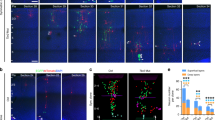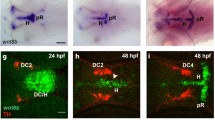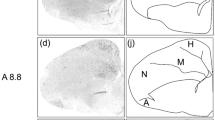Abstract
The ventral telencephalon in the embryonic brain is thought to provide guidance cues for navigation of thalamocortical axons, but the mechanisms involved remain largely elusive. OL-protocadherin (OL-pc), a member of the cadherin superfamily, is highly expressed by striatal neurons in the developing ventral telencephalon. Here we show that OL-pc–deficient (Pcdh10−/−) mice have defects in axon pathways through the ventral telencephalon; for example, thalamocortical and corticothalamic projections cannot cross the ventral telencephalon. In the ventral telencephalon, striatal axons fail to grow out, and, concomitantly, the caudal portion of the globus pallidus and the associated 'corridor' thought to be important for thalamocortical fiber navigation do not form. The inability of the striatum to extend axons is also observed in vitro. These results show that OL-pc is essential for both elongation of striatal axons and patterning of the putative guidance cues for thalamocortical projections.
This is a preview of subscription content, access via your institution
Access options
Subscribe to this journal
Receive 12 print issues and online access
$209.00 per year
only $17.42 per issue
Buy this article
- Purchase on Springer Link
- Instant access to full article PDF
Prices may be subject to local taxes which are calculated during checkout







Similar content being viewed by others
References
Lopez-Bendito, G. & Molnar, Z. Thalamocortical development: how are we going to get there? Nat. Rev. Neurosci. 4, 276–289 (2003).
Garel, S. & Rubenstein, J.L. Intermediate targets in formation of topographic projections: inputs from the thalamocortical system. Trends Neurosci. 27, 533–539 (2004).
Hanashima, C., Molnar, Z. & Fishell, G. Building bridges to the cortex. Cell 125, 24–27 (2006).
Metin, C., Deleglise, D., Serafini, T., Kennedy, T.E. & Tessier-Lavigne, M. A role for netrin-1 in the guidance of cortical efferents. Development 124, 5063–5074 (1997).
Seibt, J. et al. Neurogenin2 specifies the connectivity of thalamic neurons by controlling axon responsiveness to intermediate target cues. Neuron 39, 439–452 (2003).
Dufour, A. et al. Area specificity and topography of thalamocortical projections are controlled by ephrin/Eph genes. Neuron 39, 453–465 (2003).
Jones, L., Lopez-Bendito, G., Gruss, P., Stoykova, A. & Molnar, Z. Pax6 is required for the normal development of the forebrain axonal connections. Development 129, 5041–5052 (2002).
Lopez-Bendito, G., Chan, C.H., Mallamaci, A., Parnavelas, J. & Molnar, Z. Role of Emx2 in the development of the reciprocal connectivity between cortex and thalamus. J. Comp. Neurol. 451, 153–169 (2002).
Polleux, F. Genetic mechanisms specifying cortical connectivity: let's make some projections together. Neuron 46, 395–400 (2005).
Mitrofanis, J. & Guillery, R.W. New views of the thalamic reticular nucleus in the adult and the developing brain. Trends Neurosci. 16, 240–245 (1993).
Metin, C. & Godement, P. The ganglionic eminence may be an intermediate target for corticofugal and thalamocortical axons. J. Neurosci. 16, 3219–3235 (1996).
Molnar, Z., Adams, R. & Blakemore, C. Mechanisms underlying the early establishment of thalamocortical connections in the rat. J. Neurosci. 18, 5723–5745 (1998).
Tuttle, R., Nakagawa, Y., Johnson, J.E. & O'Leary, D.D. Defects in thalamocortical axon pathfinding correlate with altered cell domains in Mash-1–deficient mice. Development 126, 1903–1916 (1999).
Lopez-Bendito, G. et al. Tangential neuronal migration controls axon guidance: a role for neuregulin-1 in thalamocortical axon navigation. Cell 125, 127–142 (2006).
Molnar, Z. & Blakemore, C. How do thalamic axons find their way to the cortex? Trends Neurosci. 18, 389–397 (1995).
Hirano, S., Suzuki, S.T. & Redies, C. The cadherin superfamily in neural development: diversity, function and interaction with other molecules. Front. Biosci. 8, d306–d355 (2003).
Redies, C., Vanhalst, K. & Roy, F. δ-Protocadherins: unique structures and functions. Cell. Mol. Life Sci. 62, 2840–2852 (2005).
Yamagata, K. et al. Arcadlin is a neural activity-regulated cadherin involved in long term potentiation. J. Biol. Chem. 274, 19473–19479 (1999).
Phillips, G.R. et al. γ-Protocadherins are targeted to subsets of synapses and intracellular organelles in neurons. J. Neurosci. 23, 5096–5104 (2003).
Wang, X. γ-Protocadherins are required for survival of spinal interneurons. Neuron 36, 843–854 (2002).
Hirano, S., Yan, Q. & Suzuki, S.T. Expression of a novel protocadherin, OL-protocadherin, in a subset of functional systems of the developing mouse brain. J. Neurosci. 19, 995–1005 (1999).
Luckner, R., Obst-Pernberg, K., Hirano, S., Suzuki, S.T. & Redies, C. Granule cell raphes in the developing mouse cerebellum. Cell Tissue Res. 303, 159–172 (2001).
Aoki, E., Kimura, R., Suzuki, S.T. & Hirano, S. Distribution of OL-protocadherin protein in correlation with specific neural compartments and local circuits in the postnatal mouse brain. Neuroscience 117, 593–614 (2003).
Muller, K., Hirano, S., Puelles, L. & Redies, C. OL-protocadherin expression in the visual system of the chicken embryo. J. Comp. Neurol. 470, 240–255 (2004).
Nakao, S. et al. Distribution of OL-protocadherin in axon fibers in the developing chick nervous system. Brain Res. Mol. Brain Res. 134, 294–308 (2005).
Nakashiba, T., Nishimura, S., Ikeda, T. & Itohara, S. Complementary expression and neurite outgrowth activity of netrin-G subfamily members. Mech. Dev. 111, 47–60 (2002).
Kimura, J. et al. Emx2 and Pax6 function in cooperation with Otx2 and Otx1 to develop caudal forebrain primordium that includes future archipallium. J. Neurosci. 25, 5097–5108 (2005).
Shinozaki, K. et al. Absence of Cajal-Retzius cells and subplate neurons associated with defects of tangential cell migration from ganglionic eminence in Emx1/2 double mutant cerebral cortex. Development 129, 3479–3492 (2002).
Garel, S., Marin, F., Grosschedl, R. & Charnay, P. Ebf1 controls early cell differentiation in the embryonic striatum. Development 126, 5285–5294 (1999).
Garel, S., Yun, K., Grosschedl, R. & Rubenstein, J.L. The early topography of thalamocortical projections is shifted in Ebf1 and Dlx1/2 mutant mice. Development 129, 5621–5634 (2002).
Yun, K., Garel, S., Fischman, S. & Rubenstein, J.L. Patterning of the lateral ganglionic eminence by the Gsh1 and Gsh2 homeobox genes regulates striatal and olfactory bulb histogenesis and the growth of axons through the basal ganglia. J. Comp. Neurol. 461, 151–165 (2003).
Tissir, F., Bar, I., Jossin, Y., De Backer, O. & Goffinet, A.M. Protocadherin Celsr3 is crucial in axonal tract development. Nat. Neurosci. 8, 451–457 (2005).
Takeichi, M. The cadherin superfamily in neuronal connections and interactions. Nat. Rev. Neurosci. 8, 11–20 (2007).
Chen, X. & Gumbiner, B.M. Paraxial protocadherin mediates cell sorting and tissue morphogenesis by regulating C-cadherin adhesion activity. J. Cell Biol. 174, 301–313 (2006).
Wattler, S., Kelly, M. & Nehls, M. Construction of gene targeting vectors from lambda KOS genomic libraries. BioTechniques 26, 1150–1156, 1158, 1160 (1999).
Okabe, M., Ikawa, M., Kominami, K., Nakanishi, T. & Nishimune, Y. 'Green mice' as a source of ubiquitous green cells. FEBS Lett. 407, 313–319 (1997).
Suto, F., Murakami, Y., Nakamura, F., Goshima, Y. & Fujisawa, H. Identification and characterization of a novel mouse plexin, plexin-A4. Mech. Dev. 120, 385–396 (2003).
Toresson, H., Potter, S.S. & Campbell, K. Genetic control of dorsal-ventral identity in the telencephalon: opposing roles for Pax6 and Gsh2. Development 127, 4361–4371 (2000).
Inoue, T., Nakamura, S. & Osumi, N. Fate mapping of the mouse prosencephalic neural plate. Dev. Biol. 219, 373–383 (2000).
Kitsukawa, T. et al. Neuropilin-semaphorin III/D–mediated chemorepulsive signals play a crucial role in peripheral nerve projection in mice. Neuron 19, 995–1005 (1997).
Hogan, B., Beddington, R., Costantini, F. & Lacy, E. Manipulating the Mouse Embryo: A Laboratory Manual 2nd edn. (Cold Spring Harbor Laboratory Press, Cold Spring Harbor, New York, 1994).
Ulupinar, E., Datwani, A., Behar, O., Fujisawa, H. & Erzurumlu, R. Role of semaphorin III in the developing rodent trigeminal system. Mol. Cell. Neurosci. 13, 281–292 (1999).
Acknowledgements
We thank G. Eguchi for encouragement during the JST PRESTO project. The OL-pc knockout mouse line was generated by Lexicon Pharmaceuticals and maintained by the animal facility in RIKEN CDB with help of H. Miyachi. We thank Y. Suda and S. Aizawa (RIKEN Center for Developmental Biology) for Pax6 and Emx2 mutant mice; Y. Suda for Ebf1, H. Fujisawa (Nagoya University) for Slit1, Slit2 and Neuropilin-2, and M. Tessier-Lavigne (Genentech) for Netrin-1 probe DNAs; T. Terashima, N. Yamamoto and G. Lopez-Bendito for technical guidance; K. Campbell (Cincinnati Children's Hospital Medical Center, University of Cincinnati), N. Osumi (Tohoku University) and S. Itohara (RIKEN Brain Science Institute) for antibodies to Gsh2, Pax6 and Netrin-G1, respectively; E. Aoki and A. Nakayama for the initial phase of the experiments; J.L. Rubenstein, O. Marin and C. Redies for discussion; and H. Ishigami, M. Nomura and C. Yoshii for technical assistance. S.N. is a recipient of a Fellowship of the Japan Society for the Promotion of Science for Junior Scientists. This work was supported by grants (to M.T.) from the program Grants-in-Aid for Specially Promoted Research.
Author information
Authors and Affiliations
Contributions
M.U. conducted experiments and analyzed the mutant mouse data. S.N. analyzed specific phenotypes of the mutant mice. S.T.S. supervised the project in the early phase. M.T. supervised the project and wrote the manuscript. S.H. planned the project and contributed to every aspect.
Corresponding authors
Ethics declarations
Competing interests
The authors declare no competing financial interests.
Supplementary information
Supplementary Text and Figures
Supplementary Figures 1–9, Table 1 (PDF 6651 kb)
Rights and permissions
About this article
Cite this article
Uemura, M., Nakao, S., Suzuki, S. et al. OL-protocadherin is essential for growth of striatal axons and thalamocortical projections. Nat Neurosci 10, 1151–1159 (2007). https://doi.org/10.1038/nn1960
Received:
Accepted:
Published:
Issue Date:
DOI: https://doi.org/10.1038/nn1960
This article is cited by
-
The role of Pcdh10 in neurological disease and cancer
Journal of Cancer Research and Clinical Oncology (2023)
-
Innovative mouse models for the tumor suppressor activity of Protocadherin-10 isoforms
BMC Cancer (2022)
-
Nolz1 expression is required in dopaminergic axon guidance and striatal innervation
Nature Communications (2020)
-
Human Pluripotent Stem Cell-Derived Neurons Are Functionally Mature In Vitro and Integrate into the Mouse Striatum Following Transplantation
Molecular Neurobiology (2020)
-
Synaptic N6-methyladenosine (m6A) epitranscriptome reveals functional partitioning of localized transcripts
Nature Neuroscience (2018)



